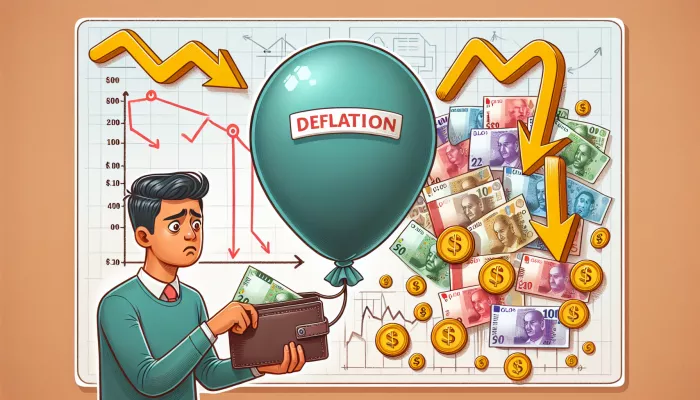
When we talk about economy, we usually hear more about inflation, which is the rise in prices.
However, there is an opposite phenomenon, called deflation, which has a significant impact on purchasing power.
Deflation occurs when the prices of goods and services fall over time, which may seem good at first glance.
However, it has complex effects that are worth understanding.

Deflation happens for a variety of reasons, including a decrease in demand for goods and services or an increase in the availability of products.
Although it may seem beneficial as product prices fall, it can lead to a negative cycle for the economy.
Consumers may delay purchases, hoping that prices will fall further, which reduces overall demand and may lead companies to reduce production, investment and possibly cut jobs.
Initially, deflation may increase the purchasing power, since consumers are able to buy more with the same amount of money. In the very short term, this seems like an advantage.
However, in the long run, deflation can cause a deflationary spiral.
This happens when continued price reductions lead to lower wages, fewer jobs, and consequently, lower purchasing power. This cycle can be difficult to break once it starts.
Understanding how deflation works and how it affects purchasing power is essential.
Adjusting financial strategies, such as maintaining investment diversification and increasing emergency reserves, can help mitigate the negative effects of deflation.
Furthermore, being alert to market changes and adapting quickly can protect against the more challenging aspects of deflation.
Conclusion: While deflation may seem advantageous at first due to falling prices, it poses significant challenges to purchasing power and the economy as a whole.
Understanding its effects and being prepared can help individuals and businesses navigate this scenario more safely.
Understanding how deflation affects the market and your money is crucial to safely navigating the economy.
Deflation, being the opposite of inflation, occurs when the overall prices of goods and services fall.
This economic phenomenon has a direct impact in several areas, from consumers' purchasing power to governments' monetary policies.
Deflation may seem beneficial in the short term as it increases consumers' purchasing power.
If prices fall, with the same amount of money you can buy more products and services.
However, this situation can lead to a dangerous deflationary cycle, where the expectation of even lower prices in the future causes consumers and companies to postpone purchases and investment.
Respectively, reducing overall demand and potentially resulting in an economic slowdown.
From a business perspective, deflation increases the risk of lag between costs and revenues.
With selling prices falling, but costs often fixed or falling at a slower pace, profit margins are under pressure.
This can lead to cuts in production, investment and, ultimately, jobs, negatively affecting the labor market and the economy as a whole.
Deflation exerts a pressure on debtors, increasing the real weight of their debts.
In a deflationary environment, even if the nominal interest rate is maintained, the real cost of borrowing may increase, making it difficult to pay off debts and discouraging new loans and investments.
This can have a negative impact on business expansion, innovation and ultimately economic growth.
To protect your finances during periods of deflation, it is recommended diversify investments.
Choose assets that tend to maintain or increase their value even in deflationary periods, such as short-term government bonds, and maintain a conservative stance regarding debt.
Furthermore, having a well-established emergency fund becomes even more important to cover unexpected expenses without having to resort to loans.
In summary, deflation has the potential to profoundly influence the market and your money, affecting everything from purchasing power to investment decisions.
Understanding these effects and preparing accordingly can help you navigate these challenging times, protecting your finances and contributing to economic stability.
When faced with a deflationary scenario, it is crucial to adopt effective strategies to protect our finances.
Deflation, characterized by a general decline in prices, may seem beneficial at first glance, but it presents significant challenges, such as reduced consumption and investment.
Below, we explore some prudent strategies to safeguard your financial health during these times.
Prioritize debt repayment is essential during deflation. As prices fall, the real value of debts can increase, making them more onerous over time.
Focus on paying off the highest interest debts first, this not only reduces your financial burden but also improves your credit profile.
The construction of a emergency reserve robust is a smart move.
This fund acts as a buffer against unemployment or other financial setbacks, which may be more common during deflationary periods.
Ideally, this reserve should cover three to six months of living expenses.
While the market may look less attractive during deflation, some investment opportunities may still arise.
Diversifying your investments is key; consider safer options like government bonds or high-yield savings accounts.
Consult a financial advisor for guidance tailored to your profile.
Reevaluate your consumption habits. Deflation provides the opportunity to purchase goods and services at lower prices, allowing you to stretch your budget.
Take advantage of the opportunity to purchase durable and necessary items at a lower cost, but avoid the trap of spending just to find a good deal.
Useful links:
Staying well informed about economic conditions can help you make better financial decisions.
Follow the news, read economic reports, and stay tuned to forecasts to adjust your strategies as needed.
Remember, financial success during a period of deflation requires a proactive and adaptive approach.
By implementing these strategies, you can not only protect your finances, but also position yourself for future economic growth.